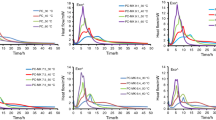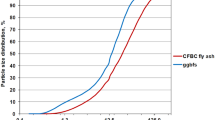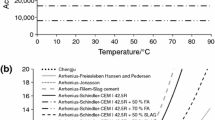Abstract
The heat of hydration evolution of eight paste mixtures of various water to binder ratio and containing various pozzolanic (silica fume, fly ash) and latent hydraulic (granulated blast furnace slag) admixtures have been studied by means of isothermal calorimetry during the first 7 days of the hydration process and by means of solution calorimetry for up to 120 days. The results of early heat of hydration values obtained by both methods are comparable in case of the samples without mineral admixtures; the values obtained for samples containing fly ash and granulated blast furnace slag differ though. The results from isothermal calorimetry show an acceleration of the hydration process by the presence of the fine particles of silica fume and retarding action of other mineral admixtures and superplasticizer. The influence of the presence of mineral admixtures on higher heat development (expressed as joules per gram of cement in mixture) becomes apparent after 20 h in case of fly ash without superplasticizer and after 48 h for sample containing fly ash and superplasticizer. In case of samples containing slag and superplasticizer the delay observed was 40 h. The results obtained by solution calorimetry provide a good complement to the ones of isothermal calorimetry, as the solution calorimetry enables to study the contribution of the mineral admixtures to the hydration heat development at later ages of the hydration process, which is otherwise hard to obtain by different methods.





Similar content being viewed by others
References
Khatib JM. Metakaolin concrete at a low water to binder ratio. Constr Build Mater. 2008;22:1691–700.
Vessalas K, et al. Pozzolanic reactivity of the supplementary cementitious material pitchstone fines by thermogravimetric analysis. J Therm Anal Calorim. 2009;97:71–6.
Erdem TK, Kirca Ö. Use of binary and ternary blends in high strength concrete. Constr Build Mater. 2008;22:1477–83.
Habert G, et al. Effects of the secondary minerals of the natural pozzolans on their pozzolanic activity. Cem Concr Res. 2008;38:963–75.
Ježo L, Palou M, Kozánková J, Ifka T. Determination of activation effect of Ca(OH)2 upon the hydration of BFS and related heat by isothermal calorimeter. J Therm Anal Calorim. 2010;101:585–93.
Brandštetr J, Polcer J, Krátký J, Holešinský R, Havlica J. Possibilities of the use of isoperibolic calorimetry for assessing the hydration behavior of cementitious systems. Cem Concr Res. 2001;3:941–7.
Krátký J, Havlica J, Brandštetr J. Contribution of calorimetric methods for the assessing the reactivity of components of cementitious systems. In: Non-traditional cements & concrete, Brno: Brno University of Technology. 2002;162–6.
Wild S, Khatib JM. Portlandite consumption in metakaolin cement pastes and mortars. Cem Concr Res. 1997;27:137–46.
Duchesne J, Reardon EJ. Measurement and prediction of portlandite solubility in alkali solutions. Cem Concr Res. 1995;25:1043–53.
Glasser FP, Marchand J, Samson E. Durability of concrete—degradation phenomena involving detrimental chemical reactions. Cem Concr Res. 2008;38:226–46.
Oner A, Akyuz S. An experimental study on optimum usage of GGBS for the compressive strength of concrete. Cem Concr Comp. 2007;29:505–14.
Korpa A, Kowald T, Trettin R. Hydration behaviour, structure and morphology of hydration phases in advanced cement-based systems containing micro and nanoscale pozzolanic additives. Cem Concr Res. 2008;38:955–62.
Pane I, Hansen W. Investigation of blended cement hydration by isothermal calorimetry and thermal analysis. Cem Concr Res. 2005;35:1155–64.
Plank J, et al. Synthesis and performance of methacrylic ester based polycarboxylate superplasticizers possessing hydroxy terminated poly(ethylene glycol) side chains. Cem Concr Res. 2008;38:1210–6.
Zingg A, et al. The microstructure of dispersed and non-dispersed fresh cement pastes—new insight by cryo microscopy. Cem Concr Res. 2008;38:522–9.
Atiş CD. Heat evolution of high-volume fly ash concrete. Cem Concr Res. 2002;32:751–6.
Rahhal V, Talero R. Influence of two different fly ashes on the hydration of portland cements. J Therm Anal Calorim. 2004;78:191–205.
Wang A, Zhang Ch, Sun W. Fly ash effects II. The active effect of fly ash. Cem Concr Res. 2004;34:2057–60.
Pacewska B, Blonkowski G, Wilinska I. Investigations of the influence of different fly ashes on cement hydration. J Therm Anal Calorim. 2006;86:179–86.
Gruyaert E, Robeyst N, De Belie N. Modelling the hydration heat of Portland cement blended with blastfurnace slag. In: Non-traditional cement and concrete III, Brno: Brno University of technology. 2008;302–11.
Gruyaert E, Robeyst N, De Belie N. Study of the hydration of Portland cement blended with blast-furnace slag by calorimetry and thermogravimetry. J Therm Anal Calorim. 2010;102:941–51.
Krátký J, Havlica J, Brandštetr J, Krátký J. The use of calorimetry in the analysis and rapid quality tests of fly ashes, binders and mixes. In: Chemické listy, Proceedings of the 2nd Meeting of Chemistry and Life, Brno, 2002;215–18.
Brandštetr J, Krátký J, Havlova J, Pospíšil O. Použití roztokové kalorimetrie (entalpimetrie) při anlýze a zkouškách reaktivity surovin a výrobků maltovinářského průmyslu, (The use of solution calorimetry (entalpimetri) in analysis and tests of reactivity of raw materials and products of mortary industry). Silika. 2002;5–6:177–80.
Baert G, Hoste S, De Schutter G, De Belie N. Reactivity of fly ash in cement paste studied by means of thermogravimetry and isothermal calorimetry. J Therm Anal Calorim. 2008;94:485–92.
Haines PJ. Principles of thermal analysis and calorimetry. Royal Society of Chemistry, 2002;145–7.
De Schutter G. Hydration and temperature development of concrete made with blast-furnace slag cement. Cem Concr Res. 1999;29:143–9.
NBN_EN 196-8:2003 (E). Methods of testing cement—Part 8: heat of hydration—solution method.
Stephan D, Dikoundou SN, Raudaschl-Sieber G. Hydration characteristics and hydration products of tricalcium silicate doped with a combination of MgO, Al2O3 and Fe2O3. Thermochim Acta. 2008;472:64–73.
Aitcin PC. Vysokohodnotný beton, (High performance concrete), Praha, ČKAIT, 2005.
Rahhal V, Talero R. Fast physics-chemical and calorimetric characterization of natural pozzolans and other aspects. J Therm Anal Calorim. 2010;99:479–86.
Sakai E, Kasuga T, Sugiyama T, Asaga K, Daimon M. Influence of superplasticizers on the hydration of cement and the pore structure of hardened cement. Cem Concr Res. 2006;36:2049–53.
Rahhal V, Cabrera O, Talero R, Delgado A. Calorimetry of portland cement with silica fume and gypsum additions. J Therm Anal Calorim. 2007;87:331–6.
Escalante JI. Reactivity of blast-furnace slag in Portland cement blends hydrated under different conditions. Cem Concr Res. 2001;31:1403–9.
Hanehara S, Tomosawa F, Kobayakawa M, Hwang KR. Effects of water/powder ratio, mixing ratio of fly ash, and curing temperature on pozzolanic reaction of fly ash in cement paste. Cem Concr Res. 2001;31:31–9.
Mostafa NY, EL-Hemaly SAS, Al-Wakeel EI, El-Korashy SA. Activity of silica fume and dealuminated kaolin at different temperatures. Cem Concr Res. 2001;31:905–11.
Acknowledgements
This research was made possible thanks to project ERDF CZ.1.05/2.1.00/01.0012. The authors would like to thank the staff the Magnel Laboratory for Concrete Research for technical help and advice.
Author information
Authors and Affiliations
Corresponding author
Rights and permissions
About this article
Cite this article
Siler, P., Kratky, J. & De Belie, N. Isothermal and solution calorimetry to assess the effect of superplasticizers and mineral admixtures on cement hydration. J Therm Anal Calorim 107, 313–320 (2012). https://doi.org/10.1007/s10973-011-1479-8
Received:
Accepted:
Published:
Issue Date:
DOI: https://doi.org/10.1007/s10973-011-1479-8




